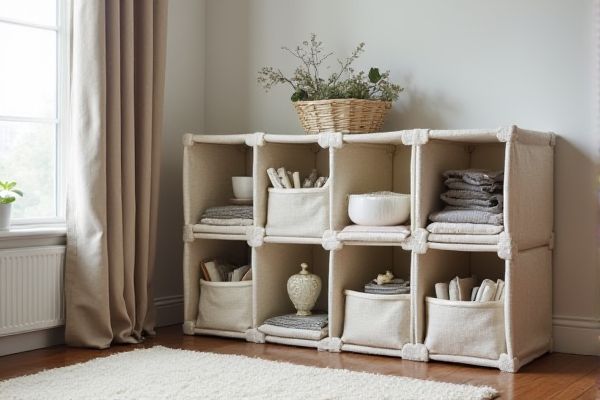
Fabric storage cubes offer a lightweight, breathable option that is gentle on clothes and easy to fold when not in use, while plastic storage cubes provide more rigid, durable protection ideal for stacking and long-term storage. Discover which storage solution suits your needs best by reading the rest of the article.
Table of Comparison
| Feature | Fabric Storage Cubes | Plastic Storage Cubes |
|---|---|---|
| Material | Breathable fabric, often polyester or cotton blends | Durable plastic, usually polypropylene or polyethylene |
| Weight | Lightweight and easy to move | Heavier and more rigid |
| Durability | Moderate; prone to wear and tear over time | High; resistant to impact and moisture |
| Cleaning | Machine washable or spot clean | Wipe clean with a damp cloth |
| Flexibility | Collapsible for easy storage when not in use | Rigid, non-collapsible |
| Aesthetic | Soft, fabric texture with multiple colors and patterns | Sleek, solid color appearance, often transparent or opaque |
| Cost | Generally more affordable | Usually higher price due to sturdiness |
| Best Use | Closet organization, lightweight storage, decorative purposes | Garage, basement, heavy-duty storage, moisture-prone areas |
Introduction to Fabric and Plastic Storage Cubes
Fabric storage cubes offer lightweight, breathable, and flexible organization solutions ideal for closets and shelves, blending seamlessly with home decor. Plastic storage cubes provide durable, sturdy, and moisture-resistant options suited for heavy-duty storage and outdoor use. Both types cater to different storage needs, emphasizing portability and protection respectively.
Material Composition and Durability
Fabric storage cubes are made from woven textiles such as polyester or cotton blends, offering breathability and flexibility, which helps prevent moisture buildup and protects delicate items. Plastic storage cubes, composed of rigid polymers like polypropylene, provide superior durability, water resistance, and ease of cleaning but may lack ventilation, leading to potential condensation issues. Your choice depends on whether you prioritize the lightweight, soft structure of fabric cubes or the sturdy, moisture-proof qualities of plastic options for long-term storage.
Aesthetic Appeal and Design Options
Fabric storage cubes offer a softer, more versatile aesthetic with a wide range of colors, patterns, and textures that can seamlessly blend into your home decor. Plastic storage cubes typically provide a more utilitarian look, often limited to clear or solid colors with a glossy finish, which might not complement all interior styles. You can choose fabric cubes to add warmth and style to any space, while plastic cubes prioritize durability and a clean, modern appearance.
Weight and Portability
Fabric storage cubes are significantly lighter than plastic storage cubes, making them more portable and easier to move around your home or office. Their soft, collapsible design allows for convenient transportation and storage when not in use, unlike rigid plastic cubes which are bulkier and heavier. Choosing fabric storage cubes enhances your ability to rearrange or pack your storage solutions without added strain or effort.
Storage Capacity and Flexibility
Fabric storage cubes offer greater flexibility due to their lightweight, collapsible design, allowing them to fit into various spaces and expand as needed. Plastic storage cubes typically provide more rigid, uniform storage capacity with sturdier walls, ideal for stacking and protecting heavier items. The choice depends on whether adjustable storage and portability or structural durability and consistent shape are prioritized.
Cleaning and Maintenance Requirements
Fabric storage cubes require gentle cleaning with a damp cloth or mild detergent to prevent damage to the material, while plastic storage cubes can be easily wiped down with disinfectant or washed with soap and water for thorough cleaning. Fabric cubes may accumulate dust and stains more readily, necessitating more frequent spot cleaning or occasional hand washing. Plastic cubes are more resistant to moisture and stains, offering a low-maintenance solution ideal for environments prone to spills or dirt.
Environmental Impact and Sustainability
Fabric storage cubes are typically made from natural or recycled fibers, making them biodegradable and less harmful to the environment compared to plastic storage cubes, which are often produced from non-renewable petroleum-based materials. The production and disposal of plastic cubes contribute significantly to pollution, including microplastic contamination and landfill accumulation, whereas fabric cubes offer better sustainability by decomposing more easily and reducing long-term waste. Choosing fabric storage cubes supports eco-friendly practices by promoting renewable resources and minimizing environmental footprints in home organization.
Cost Comparison and Value for Money
Fabric storage cubes typically cost less than plastic storage cubes, offering an affordable option for organizing spaces on a budget. Their lightweight, collapsible design enhances convenience and portability, increasing overall value for money. Plastic storage cubes, while more expensive, provide durability and water resistance, justifying the higher price for long-term or heavy-duty use.
Best Use Cases for Each Type
Fabric storage cubes excel for lightweight items like clothes, toys, and linens, offering flexibility and breathability ideal for wardrobes and closets. Plastic storage cubes are best suited for heavy-duty storage needs, such as tools, seasonal decorations, or garage supplies, providing durability, moisture resistance, and stackability. Your choice depends on whether you prioritize ventilation and aesthetic integration or strength and protection against elements.
Final Considerations: Choosing the Right Storage Cube
Fabric storage cubes offer breathable, lightweight organization ideal for soft items like clothing or linens, while plastic storage cubes provide durable, moisture-resistant protection suited for heavier or more delicate belongings. Your choice depends on the specific storage environment and the nature of the items, balancing aesthetics, protection, and accessibility. Considering factors like material durability, airflow, and the type of items you need to store ensures you select the right storage cube for efficient and long-lasting organization.
 homyna.com
homyna.com